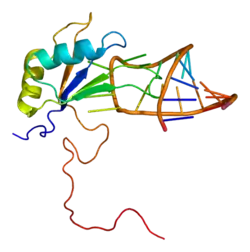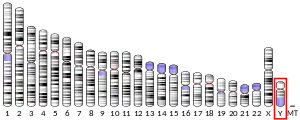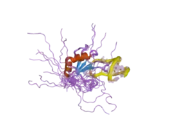RNA binding motif protein, Y-linked, family 1, member A1
RNA-binding motif protein, Y chromosome, family 1 member A1/C is a protein that in humans is encoded by the RBMY1A1 gene.[3][4][5]
| RBMY1A1 | |||||||||||||||||||||||||||||||||||||||||||||||||||
|---|---|---|---|---|---|---|---|---|---|---|---|---|---|---|---|---|---|---|---|---|---|---|---|---|---|---|---|---|---|---|---|---|---|---|---|---|---|---|---|---|---|---|---|---|---|---|---|---|---|---|---|
 | |||||||||||||||||||||||||||||||||||||||||||||||||||
| |||||||||||||||||||||||||||||||||||||||||||||||||||
| Identifiers | |||||||||||||||||||||||||||||||||||||||||||||||||||
| Aliases | RBMY1A1, RBM, RBM1, RBM2, RBMY, RBMY1C, YRRM1, YRRM2, RNA binding motif protein, Y-linked, family 1, member A1, RNA binding motif protein Y-linked family 1 member A1 | ||||||||||||||||||||||||||||||||||||||||||||||||||
| External IDs | OMIM: 400006 HomoloGene: 121598 GeneCards: RBMY1A1 | ||||||||||||||||||||||||||||||||||||||||||||||||||
| |||||||||||||||||||||||||||||||||||||||||||||||||||
| |||||||||||||||||||||||||||||||||||||||||||||||||||
| |||||||||||||||||||||||||||||||||||||||||||||||||||
| |||||||||||||||||||||||||||||||||||||||||||||||||||
| Wikidata | |||||||||||||||||||||||||||||||||||||||||||||||||||
| |||||||||||||||||||||||||||||||||||||||||||||||||||
This gene encodes a protein containing an RNA-binding motif in the N-terminus and four SRGY (serine, arginine, glycine, tyrosine) boxes in the C-terminus. Multiple copies of this gene are found in the AZFb azoospermia factor region of chromosome Y and the encoded protein is thought to be involved in spermatogenesis. Most copies of this locus are pseudogenes, although six highly similar copies have full-length ORFs and are considered functional. Four functional copies of this gene are found within inverted repeat IR2; two functional copies of this gene are found in palindrome P3, along with two copies of PTPN13-like, Y-linked. Alternative splicing of transcripts results in two transcript variants that encode different proteins.[5]
References
- GRCh38: Ensembl release 89: ENSG00000234414 - Ensembl, May 2017
- "Human PubMed Reference:". National Center for Biotechnology Information, U.S. National Library of Medicine.
- Ma K, Inglis JD, Sharkey A, Bickmore WA, Hill RE, Prosser EJ, Speed RM, Thomson EJ, Jobling M, Taylor K, et al. (Jan 1994). "A Y chromosome gene family with RNA-binding protein homology: candidates for the azoospermia factor AZF controlling human spermatogenesis". Cell. 75 (7): 1287–95. doi:10.1016/0092-8674(93)90616-X. PMID 8269511. S2CID 24678568.
- Chai NN, Zhou H, Hernandez J, Najmabadi H, Bhasin S, Yen PH (Aug 1998). "Structure and organization of the RBMY genes on the human Y chromosome: transposition and amplification of an ancestral autosomal hnRNPG gene". Genomics. 49 (2): 283–9. doi:10.1006/geno.1998.5255. PMID 9598316.
- "Entrez Gene: RBMY1A1 RNA binding motif protein, Y-linked, family 1, member A1".
Further reading
- Lavery R, Glennon M, Houghton J, et al. (2007). "Investigation of DAZ and RBMY1 gene expression in human testis by quantitative real-time PCR". Arch. Androl. 53 (2): 71–3. doi:10.1080/01485010600915228. PMID 17453684.
- Skrisovska L, Bourgeois CF, Stefl R, et al. (2007). "The testis-specific human protein RBMY recognizes RNA through a novel mode of interaction". EMBO Rep. 8 (4): 372–9. doi:10.1038/sj.embor.7400910. PMC 1852761. PMID 17318228.
- Lindtner S, Zolotukhin AS, Uranishi H, et al. (2007). "RNA-binding motif protein 15 binds to the RNA transport element RTÉ and provides a direct link to the NXF1 export pathway". J. Biol. Chem. 281 (48): 36915–28. doi:10.1074/jbc.M608745200. PMID 17001072.
- Gerhard DS, Wagner L, Feingold EA, et al. (2004). "The status, quality, and expansion of the NIH full-length cDNA project: the Mammalian Gene Collection (MGC)". Genome Res. 14 (10B): 2121–7. doi:10.1101/gr.2596504. PMC 528928. PMID 15489334.
- Tsuei DJ, Hsu HC, Lee PH, et al. (2004). "RBMY, a male germ cell-specific RNA-binding protein, activated in human liver cancers and transforms rodent fibroblasts". Oncogene. 23 (34): 5815–22. doi:10.1038/sj.onc.1207773. PMID 15184870.
- Skaletsky H, Kuroda-Kawaguchi T, Minx PJ, et al. (2003). "The male-specific region of the human Y chromosome is a mosaic of discrete sequence classes". Nature. 423 (6942): 825–37. Bibcode:2003Natur.423..825S. doi:10.1038/nature01722. PMID 12815422.
- Strausberg RL, Feingold EA, Grouse LH, et al. (2003). "Generation and initial analysis of more than 15,000 full-length human and mouse cDNA sequences". Proc. Natl. Acad. Sci. U.S.A. 99 (26): 16899–903. doi:10.1073/pnas.242603899. PMC 139241. PMID 12477932.
- Tsuei DJ, Chang MH, Chen PJ, et al. (2003). "Characterization of integration patterns and flanking cellular sequences of hepatitis B virus in childhood hepatocellular carcinomas". J. Med. Virol. 68 (4): 513–21. doi:10.1002/jmv.10240. PMID 12376959. S2CID 26869562.
- Friel A, Houghton JA, Glennon M, et al. (2002). "A preliminary report on the implication of RT-PCR detection of DAZ, RBMY1, USP9Y and Protamine-2 mRNA in testicular biopsy samples from azoospermic men". Int. J. Androl. 25 (1): 59–64. doi:10.1046/j.1365-2605.2002.00326.x. PMID 11869379.
- Pellizzoni L, Charroux B, Rappsilber J, et al. (2001). "A functional interaction between the survival motor neuron complex and RNA polymerase II". J. Cell Biol. 152 (1): 75–85. doi:10.1083/jcb.152.1.75. PMC 2193649. PMID 11149922.
- Elliott DJ, Bourgeois CF, Klink A, et al. (2000). "A mammalian germ cell-specific RNA-binding protein interacts with ubiquitously expressed proteins involved in splice site selection". Proc. Natl. Acad. Sci. U.S.A. 97 (11): 5717–22. Bibcode:2000PNAS...97.5717E. doi:10.1073/pnas.97.11.5717. PMC 18499. PMID 10823932.
- Venables JP, Elliott DJ, Makarova OV, et al. (2000). "RBMY, a probable human spermatogenesis factor, and other hnRNP G proteins interact with Tra2beta and affect splicing". Hum. Mol. Genet. 9 (5): 685–94. doi:10.1093/hmg/9.5.685. PMID 10749975.
- Elliott DJ, Oghene K, Makarov G, et al. (1998). "Dynamic changes in the subnuclear organisation of pre-mRNA splicing proteins and RBM during human germ cell development". J. Cell Sci. 111 (9): 1255–65. doi:10.1242/jcs.111.9.1255. PMID 9547301.
- Prosser J, Inglis JD, Condie A, et al. (1997). "Degeneracy in human multicopy RBM (YRRM), a candidate spermatogenesis gene". Mamm. Genome. 7 (11): 835–42. doi:10.1007/s003359900246. PMID 8875892. S2CID 23907707.


